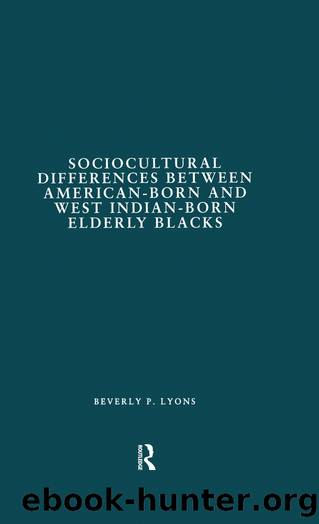Sociocultural Differences between American-born and West Indian-born Elderly Blacks by Beverly P. Lyons

Author:Beverly P. Lyons [Lyons, Beverly P.]
Language: eng
Format: epub
Tags: Social Science, Sociology, General
ISBN: 9780815330424
Google: 4GumDwAAQBAJ
Barnesnoble:
Goodreads: 3720094
Publisher: Routledge
Published: 1997-11-01T00:00:00+00:00
Need Factors
To ascertain extent of need for service as perceived by respondents, five variables were utilized including: perceived health status, perceived adequacy of income, whether respondent was a victim of crime during the past year, or were involved in taking care of grandchildren, and finally the total number of different types of help respondents felt they needed. These variables were operationalized as follows:
Perceived Health Status: Participants were asked to rate their health status. For regressions, data were recoded into four categories: Excellent = 0, Good = 1, Fair = 2, Poor = 3.
Extent of Criminal Victimization the Past Year: This variable was measured by asking whether or not participants were victims of crime in the past year. A list of frequent crimes against person or property was read to the participants to which they gave a "yes" or "no" response. This variable was computed based on the number of victimizations: none = 0, once = 1, twice = 2, three = 3, four = 4.
Perceived Number of Different Types of Help Needed: This variable was measured by asking the participants whether or not they needed help in the past year with a series of common tasks of daily life: home delivered meals; housekeeping or personal care in the home; home repairs; finding a job; personal or family counseling; someone to care for them after discharge from hospital; and someone to help them get what they are entitled to from the government. For regressions, the number of "yes's" = 1, and "no's" = 2 was totaled for this variable.
Cares Regularly for Grandchildren: This variable was coded as "yes" = 1, and "no" = 0.
Income Adequacy: To measure perceived adequacy of income, respondents were asked to indicate how well they could manage on their current income: can't make ends meet, just manage to get by, enough to get along (some extra), money not a problem. For regressions, responses were recoded: can't make ends meet = 0, just manage to get by = 1, enough to get along = 2, and money not a problem = 3.
Download
This site does not store any files on its server. We only index and link to content provided by other sites. Please contact the content providers to delete copyright contents if any and email us, we'll remove relevant links or contents immediately.
Cecilia; Or, Memoirs of an Heiress — Volume 1 by Fanny Burney(32022)
Cecilia; Or, Memoirs of an Heiress — Volume 3 by Fanny Burney(31436)
Cecilia; Or, Memoirs of an Heiress — Volume 2 by Fanny Burney(31380)
The Great Music City by Andrea Baker(30641)
We're Going to Need More Wine by Gabrielle Union(18606)
All the Missing Girls by Megan Miranda(14598)
Pimp by Iceberg Slim(13717)
Bombshells: Glamour Girls of a Lifetime by Sullivan Steve(13665)
Fifty Shades Freed by E L James(12886)
Talking to Strangers by Malcolm Gladwell(12814)
Norse Mythology by Gaiman Neil(12786)
For the Love of Europe by Rick Steves(11331)
Crazy Rich Asians by Kevin Kwan(8861)
Mindhunter: Inside the FBI's Elite Serial Crime Unit by John E. Douglas & Mark Olshaker(8665)
The Lost Art of Listening by Michael P. Nichols(7125)
Enlightenment Now: The Case for Reason, Science, Humanism, and Progress by Steven Pinker(6852)
The Four Agreements by Don Miguel Ruiz(6284)
Bad Blood by John Carreyrou(6255)
Weapons of Math Destruction by Cathy O'Neil(5801)
